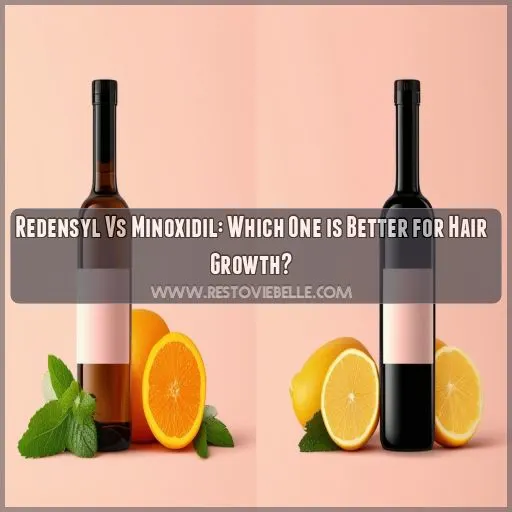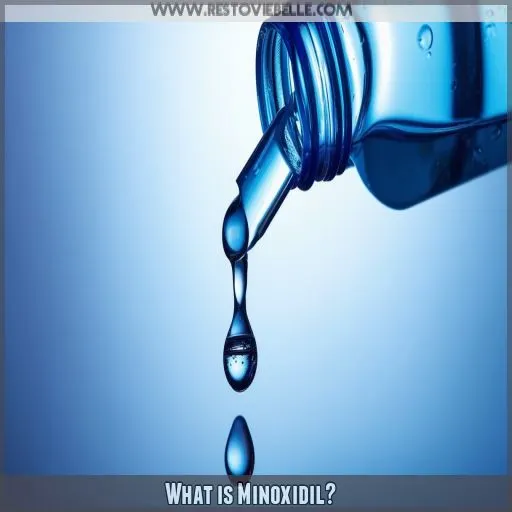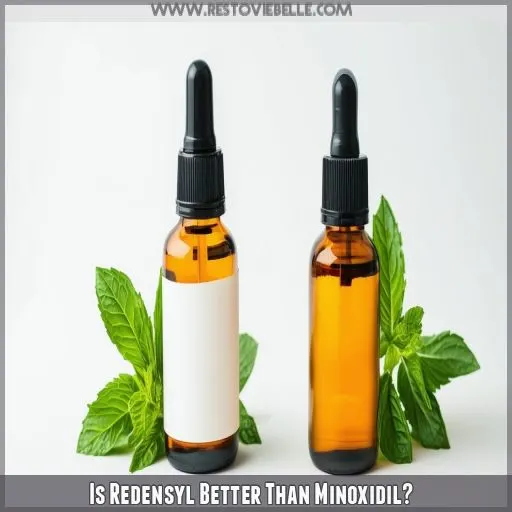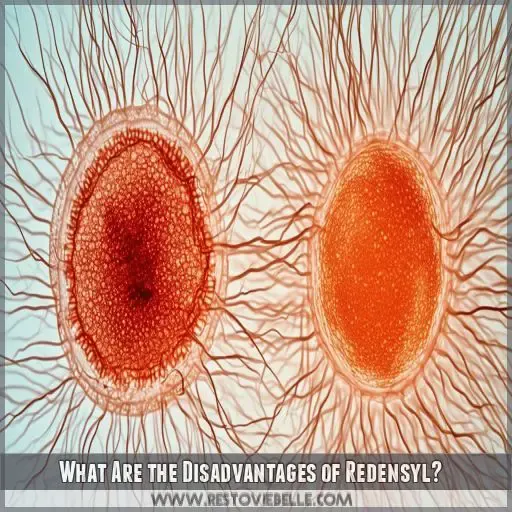This site is supported by our readers. We may earn a commission, at no cost to you, if you purchase through links.

The market is packed with options, from the well-known minoxidil to newer alternatives like Redensyl.
If you’re looking for a side-by-side comparison of Redensyl vs. minoxidil, you’ve come to the right place.
In this article, we’ll break down the benefits, side effects, and differences between these two popular treatments.
Table Of Contents
- Key Takeaways
- What is Redensyl?
- What is Minoxidil?
- Redensyl Vs. Minoxidil: Which is Better?
- An Effective Alternative to Redensyl and Minoxidil
- Is Redensyl Better Than Minoxidil?
- Can I Use Redensyl and Minoxidil Together?
- Does Redensyl Treat Hair Loss?
- What Are the Disadvantages of Redensyl?
- Frequently Asked Questions (FAQs)
- What is better, Redensyl or minoxidil?
- What is the disadvantage of Redensyl?
- Does Redensyl really regrow hair?
- Does Redensyl require a prescription?
- How does Redensyl work?
- What are the side effects of Redensyl?
- Is Redensyl safe for everyone?
- Can I combine Redensyl with other treatments?
- How long does Redensyl take to work?
- Conclusion
Key Takeaways
If you’re after a natural, plant-based treatment for hair loss, Redensyl could be your go-to. It stimulates hair follicles and boosts keratin production, resulting in thicker, healthier hair.
Minoxidil, on the other hand, is a well-known and trusted option, backed by extensive research. It’s an FDA-approved medication that increases blood flow to your scalp, encouraging growth and reducing hair loss.
Both treatments are effective, but they work differently. Redensyl targets hair follicle stem cells, while Minoxidil improves blood flow to the scalp.
The choice between the two depends on personal preferences, hair loss severity, and whether you’re willing to trade a tried-and-true method for potential scalp irritation with Minoxidil, or opt for the newer, natural Redensyl treatment.
What is Redensyl?
Redensyl is a natural, plant-based ingredient that stimulates hair growth by reactivating hair follicles. It’s often found in hair care products like shampoos and serums, and it’s generally considered safe, with limited side effects.
How Does Redensyl Work?
Redensyl is a topical hair growth ingredient that works by stimulating hair follicle activity.
It’s thought to do this by increasing keratin production and improving blood flow to the scalp, nourishing hair follicles and promoting growth.
It may also inhibit the production of DHT, a hormone linked to male pattern baldness.
Clinical trials show promising results for hair growth, and some studies have shown increased hair density and new hair growth.
Benefits of Redensyl for Hair
Redensyl has many benefits for hair. It stimulates hair follicles, encouraging growth and improving hair density. Clinical trials and user testimonials suggest it’s effective for hair growth and thickness. As a natural, plant-based ingredient, it’s a great option for those seeking a non-invasive, alternative hair loss treatment.
What is Minoxidil?
Minoxidil is a well-known and trusted treatment for hair loss. It’s a topical medication that stimulates hair growth and is FDA-approved for male and female pattern baldness.
It works by increasing blood flow to your hair follicles, encouraging growth and slowing down hair loss.
How Does Minoxidil Work?
Minoxidil is an FDA-approved hair loss medication available over-the-counter and by prescription.
Typically, you apply it directly to your scalp twice a day.
As a vasodilator, it increases blood flow to your hair follicles, stimulating hair growth and slowing hair loss.
It’s generally safe, but side effects like scalp irritation and itching can happen.
Minoxidil is a well-known and trusted option for treating hair loss.
Benefits of Minoxidil for Hair
Minoxidil is a trusted, FDA-approved medication for hair loss with several benefits:
- Stimulates hair growth
- Slows down hair loss
- Generally safe and well-tolerated
- Available over-the-counter and by prescription
Redensyl Vs. Minoxidil: Which is Better?
So, which one takes the crown? Both Redensyl and Minoxidil are effective in promoting hair growth and improving hair density. However, the choice between the two depends on personal needs, hair loss severity, and individual preferences, with Redensyl being the natural alternative.
Comparative Analysis of Redensyl and Minoxidil
The Breakdown
| Redensyl | Minoxidil | |
|---|---|---|
| Mechanism | Stimulates hair follicle stem cells | Increases blood flow to hair follicles |
| Application | Topical, twice daily | Topical, twice daily |
| Side Effects | None known | Mild: scalp irritation, itching |
| Clinical Data | Limited, but promising | Extensive, well-established |
Personalised Hair Care: Choosing the Right Treatment
Choosing the right hair loss treatment can feel like a maze, right? Everyone’s hair and scalp are different, so what works for your friend mightn’t work for you.
Here’s what you need to think about when picking a hair loss treatment:
- Hair loss consultation: Chat with a dermatologist or trichologist to figure out exactly what’s causing your hair loss. This will help you find the right treatment.
- Treatment options: There are tons of different options out there, like creams, pills, and natural stuff. Weigh the pros and cons of each one and pick the one that fits your needs best.
- Individual results may vary: Remember, what works for someone else mightn’t work for you. Hair loss is unique for everyone, and it could take some time to find the right plan.
- Safety first: Always put your safety first when trying new hair loss products. Talk to a doctor before starting any new treatment, and be aware of potential side effects.
An Effective Alternative to Redensyl and Minoxidil
While Redensyl and Minoxidil are popular options, they mightn’t be the right fit for everyone. If you’re seeking an alternative hair loss treatment, there are other routes to explore.
One such option is Bio-Pilixin, a 3-step hair growth routine that nourishes hair follicles and encourages healthy hair growth. This routine includes plant growth factors developed through stem cell technology, as well as Curcuma longa, which helps extend the anagen (growth) phase of the hair cycle and promotes overall hair health. Clinical tests have shown impressive results, with 97% of users experiencing reduced hair loss. This could be a good choice if you’re looking to improve your hair health without resorting to conventional treatments.
Is Redensyl Better Than Minoxidil?
Redensyl and minoxidil are both effective treatments for hair loss and promoting hair growth. While minoxidil has more extensive research supporting its effectiveness, Redensyl is a newer, natural alternative that may offer similar benefits. Here’s a breakdown of the key considerations:
- Effectiveness: Both treatments have been shown to promote hair growth and improve hair density. Minoxidil has more research backing its efficacy, but Redensyl is also clinically proven to stimulate hair growth.
- Side Effects: Redensyl is generally well-tolerated with No known side effects. Minoxidil, while safe, may cause mild side effects such as scalp irritation, itching, and unwanted hair growth in other areas.
- Hair Growth Results: One study found that Redensyl led to more significant hair growth than minoxidil, but the study had limitations. More research is needed to confirm these results.
The choice between Redensyl and minoxidil depends on your personal needs, preferences, and hair loss severity. If you’re seeking a natural option with minimal side effects, Redensyl could be a good choice. However, if you want a more established, FDA-approved treatment, minoxidil may be preferred.
Can I Use Redensyl and Minoxidil Together?
While it’s possible to use Redensyl and Minoxidil together, consult a healthcare professional first to assess potential interactions and side effects. Remember, these ingredients work through different pathways, so combining them may enhance overall effectiveness, but there’s no scientific research confirming this.
Different Mechanisms of Action
You might be wondering if you can use Redensyl and Minoxidil together. The answer is yes, it’s possible to combine these two ingredients, but it’s important to understand their different mechanisms of action.
| Redensyl | Minoxidil | |
|---|---|---|
| Mechanism | Stimulates hair follicle stem cells and increases keratin production | Increases blood flow to hair follicles by widening blood vessels |
| Action | Targets dermal papilla fibroblasts | Delivers oxygen and nutrients to the scalp |
Consult a Healthcare Professional
When considering combining Redensyl and minoxidil, it’s important to consult a healthcare professional first. While it may be possible to use both ingredients together, a dermatologist or trichologist can provide expert advice on potential interactions or side effects. They’ll take into account your medical history and hair loss severity to determine the best treatment options for you.
Monitor Your Progress
If you decide to use Redensyl and Minoxidil together, closely monitor your progress and be aware that individual responses will vary. Remember, patience and consistency are key to seeing long-term effects on your hair health and achieving your desired hair loss results. Here are some key considerations:
- Hair Loss Journey: Document your hair loss journey with photos to track changes in hair density and overall hair health.
- Individual Response: Recognize that individual responses vary, and consult a healthcare professional if you have concerns or experience adverse effects.
- Hair Loss Success: Define what hair loss success means to you, whether it’s increased hair density, reduced hair fall, or improved hair appearance.
- Hair Loss Transformation: Understand that significant hair loss transformations take time, and be prepared to commit to a consistent routine for several months to see results.
Does Redensyl Treat Hair Loss?
While combining Redensyl and Minoxidil is possible, you should talk to a healthcare professional first. Now, let’s get to the question: Does Redensyl effectively treat hair loss?
Redensyl is a relatively new topical hair growth ingredient that has shown promising results in clinical trials. It works by stimulating hair follicle activity and increasing keratin production, which is essential for hair growth. One of its key benefits is its ability to promote hair growth by improving blood flow to the scalp, nourishing hair follicles. Additionally, it may inhibit DHT production, a hormone linked to male pattern baldness.
User testimonials and reviews report positive outcomes, including increased hair growth, thickness, and improved hair health. However, it’s important to remember that individual results may vary, and Redensyl may not work for everyone.
While Redensyl has shown effectiveness in treating hair loss, more research is needed to fully understand its long-term benefits and potential side effects. It’s always recommended to consult a doctor or dermatologist before starting any new hair care treatment, especially if you’re experiencing significant hair loss or have concerns about your hair health.
What Are the Disadvantages of Redensyl?
While Redensyl is generally considered safe, some common side effects include itching, redness, dryness, flaking, and irritation. If you experience any severe side effects, it’s important to stop using the product and consult a doctor.
Additionally, Redensyl is a relatively new ingredient, and while clinical trials show promising results, more long-term data on its efficacy and side effects is needed. User reviews can be positive, but it’s important to remember that individual results may vary, and some users may not experience the desired hair growth or thickness.
Frequently Asked Questions (FAQs)
What is better, Redensyl or minoxidil?
While Minoxidil is a longstanding, FDA-approved option, Redensyl is newer and preferred by some for its organic composition and absence of known side effects. Ultimately, the choice depends on your individual needs and preferences.
What is the disadvantage of Redensyl?
The grass isn’t always greener on the other side. Redensyl may cause scalp irritation, dryness, and allergic reactions. In some cases, it can even lead to temporary hair loss due to the shedding of old hair.
Does Redensyl really regrow hair?
Yes, Redensyl has been scientifically proven to promote hair growth by reactivating dormant hair follicles and improving hair density. However, consistent use is key to maintaining results.
Does Redensyl require a prescription?
No, Redensyl is available without a prescription. You can buy it online or over the counter.
How does Redensyl work?
Redensyl is a topical solution that stimulates hair follicle stem cells, promoting hair growth and reducing hair loss. It’s made from plant extracts and has no known side effects.
What are the side effects of Redensyl?
Common side effects include itching, redness, dryness, flaking, and irritation. If you experience severe side effects, stop using the product and consult a doctor.
Is Redensyl safe for everyone?
Redensyl is generally considered safe for most people. However, it’s always best to consult a healthcare professional before using any new product, especially if you’re pregnant or have specific concerns.
Can I combine Redensyl with other treatments?
Yes, you can combine Redensyl with other treatments, such as Procapil, to enhance hair growth results. To maximise benefits and minimise potential risks, it’s best to use dermatologist-recommended products alongside Redensyl.
How long does Redensyl take to work?
Redensyl typically takes between three and six months to show results. This is because hair growth cycles can take at least one to four months.
Conclusion
Ultimately, the choice between Redensyl and minoxidil depends on your specific needs and preferences.
Both have been shown to be effective in promoting hair growth, but they work in different ways and may have varying results for different people.
Redensyl is a newer, natural option that targets the hair follicle cells, while minoxidil is a well-established treatment that works by improving blood flow to the scalp.
Consider trying Redensyl if you’re seeking a more recent, plant-based approach with fewer potential side effects.
However, if you’re comfortable with the tried-and-true method and don’t mind potential scalp irritation, minoxidil could be your go-to choice.
Consulting a healthcare professional is always advisable to determine the best course of treatment for your unique situation.














